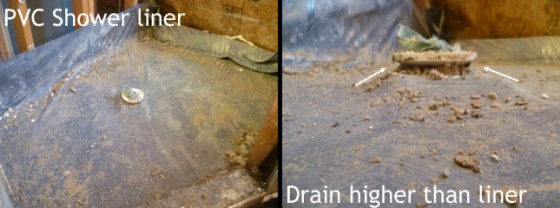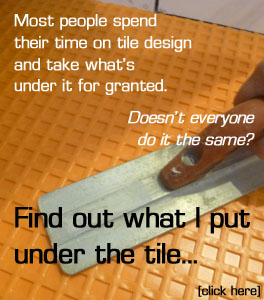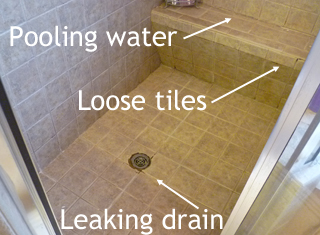 <CAUTION: Contains graphic pictures of a leaky shower>
<CAUTION: Contains graphic pictures of a leaky shower>
I get a number of opportunities to look at failing tile showers. This one surprised me because it is only FIVE YEARS OLD! The home was built new in the Providence development in Mt. Juliet, TN in 2006. When the homeowner called me to check it out I found a number of issues that pointed to more problems.
SYMPTOMS: First, there were tiles on the large tiled seat that were loose and coming off. The seat was not sloped toward the drain so water would run off! If anything, it was slightly sloped away from the drain catching water and letting it seep into the wall. I took a look in the crawlspace and could see water stains and softened subfloor in many places under the shower. This was not a plumbing issue, it was a tile shower installation problem. There were also places where the floor tile wasn’t sloped enough to allow water to drain away properly.
My client had already tried calling the original contractors who weren’t very cooperative. She was fed up and ready to have me fix the situation with some help from her homeowner’s insurance.
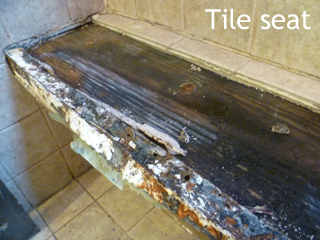 My plan was to replace the entire shower floor and remove the tiled seat entirely. The homeowner said that she’d rather just remove it than have me construct a new one. This meant tearing out the original tile around 2 feet up on all the walls. When I started pulling up tile I found more damage. The tile seat was completely saturated with water that had accumulated and the subfloor around the drain was rotted and crumbling in my fingers. I’d guess that the shower has not ‘worked’ correctly from the day it was installed.
My plan was to replace the entire shower floor and remove the tiled seat entirely. The homeowner said that she’d rather just remove it than have me construct a new one. This meant tearing out the original tile around 2 feet up on all the walls. When I started pulling up tile I found more damage. The tile seat was completely saturated with water that had accumulated and the subfloor around the drain was rotted and crumbling in my fingers. I’d guess that the shower has not ‘worked’ correctly from the day it was installed.
THE OLD WAY
I’m not an old school tile guy. Like many showers still being installed today, this one only had the PVC shower pan liner that covered the floor and went around 8 inches up the walls. The drain clamps together on the liner and is supposed to be leak free. This one, however, leaked terribly. Not only do these drains seem to be inferior to the new systems, but the method of installing the liner UNDER the sloped floor seems to be a huge problem.
What does that mean? It means that the liner is installed over the level subfloor, then decking mortar is packed on top and sloped to make the final shower floor for the tile. The problem is that water that seeps through the mortar and reaches the liner tends to collect there rather than going down the drain. This eventually leaks out somewhere and can cause mold and loose tiles because it never dries out.
You can see in the picture how the old drain is actually raised up a little from the surrounding liner. Water that reaches the liner has absolutely no chance of going down that drain.
Beyond the liner issues, the walls above the liner were just drywall with no moisture barrier of any kind. Just tile on drywall- in a shower!! This seems crazy to me, yet I see it often, when I’m ripping it out because it’s leaking! (BTW, the new waterproofing membrane systems CAN be installed over drywall in a shower, but without it, drywall in a shower is asking for trouble.)
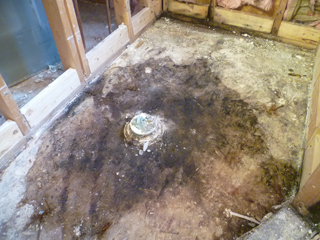 This picture (right) shows what the subfloor looked like under the pvc liner. From the discoloration, it’s obvious that the worst leaks were coming from around the drain as well as the back corner where the seat was directing water. This subfloor is made up of just one sheet of 3/4″ plywood. This is really not enough subfloor for any tile installation where you want as little flex, or deflection, in the floor as possible. This will all get cut out and I’ll replace it with two layers of 3/4″ Home Advantage subflooring.
This picture (right) shows what the subfloor looked like under the pvc liner. From the discoloration, it’s obvious that the worst leaks were coming from around the drain as well as the back corner where the seat was directing water. This subfloor is made up of just one sheet of 3/4″ plywood. This is really not enough subfloor for any tile installation where you want as little flex, or deflection, in the floor as possible. This will all get cut out and I’ll replace it with two layers of 3/4″ Home Advantage subflooring.
Of course, there are thousands of showers installed out there with this ‘system’ that perhaps work well for decades. I’m sure much of the fault lies with the installer on this one. Nonetheless, I plan to replace this faulty system with a Kerdi waterproofing system that will result in a completely waterproof (and vapor-proof!) shower that is installed over the sloped floor and insures all the water goes down the drain.
I’ll cover rebuilding the shower in my next post.

